Bhutan, also known as the Land of the Thunder Dragon, is a small landlocked country in South Asia nestled between China and India. Known for its stunning landscapes, rich cultural heritage, and strong emphasis on Gross National Happiness, Bhutan offers visitors an experience unlike any other.
Visa and Entry Requirements: All tourists, except for citizens of India, Bangladesh, and the Maldives, need a visa to enter Bhutan. It is mandatory to book your trip through a licensed Bhutanese tour operator or an international partner, who will help you with the visa application process. Visas are issued upon payment of a daily tariff that covers accommodation, transportation, meals, and an experienced guide.
Best Time to Visit: The ideal time to visit Bhutan depends on your interests and preferences. The country experiences four main seasons:
- Spring (March to May): With blooming flowers and mild temperatures, it's a great time for trekking and photography.
- Summer (June to August): This is the monsoon season with high humidity and rainfall. It's less crowded, but outdoor activities might be limited.
- Autumn (September to November): Clear skies and pleasant weather make this the peak tourist season, perfect for trekking and enjoying the numerous festivals.
- Winter (December to February): This is the coldest season, with snow in higher elevations, but offers fewer crowds and the chance to witness the endangered black-necked cranes in the Phobjikha Valley.
Getting There: The primary gateway to Bhutan is through Paro International Airport, which has connections to cities like Bangkok, Kathmandu, Singapore, and Delhi. Flights are operated by Druk Air and Bhutan Airlines. Overland travel is also possible from India through the border towns of Phuentsholing, Gelephu, and Samdrup Jongkhar.
Getting Around: Transportation in Bhutan is mostly by road, as there are no railways or domestic flights. Tour operators provide private vehicles and drivers, which is the most convenient way to explore the country. Public transport is limited and not recommended for tourists.
Top Attractions:
- Taktsang Monastery (Tiger's Nest): A sacred Buddhist site perched on a cliffside, accessible through a challenging hike with breathtaking views.
- Punakha Dzong: A beautiful fortress and monastery located at the confluence of the Pho Chhu and Mo Chhu rivers.
- Thimphu: The capital city, home to the King's Memorial Chorten, National Textile Museum, and Tashichho Dzong.
- Dochula Pass: A scenic mountain pass with panoramic views of the Himalayas and 108 memorial chortens.
- Phobjikha Valley: A picturesque valley known for its wintering population of endangered black-necked cranes.
Accommodation: Accommodation options range from standard tourist-class hotels to luxury resorts. It's essential to book your stay through a registered tour operator, as the daily tariff includes accommodation.
Cuisine: Bhutanese cuisine is characterized by its spiciness, with dishes often featuring chili peppers and cheese. Popular dishes include Ema Datshi (chili cheese), Red Rice, Phaksha Paa (pork with red chilies), and Momos (dumplings). Vegetarian options are widely available.
Safety and Etiquette: Bhutan is considered one of the safest countries to visit, with low crime rates and friendly locals. However, it's crucial to respect local customs and traditions. Dress modestly when visiting religious sites, remove your shoes before entering temples, and avoid taking photographs in restricted areas.



